Notes
- ↑ Saint Begu of Hackness at Saints.SQPN.com
- 1 2 Farmer, David (1992).Oxford Dictionary of Saints Oxford. p.44.
- 1 2 "Britannia.com". Archived from the original on 31 January 2010. Retrieved 3 February 2008.
Begu | |
|---|---|
| Nun | |
| Born | Hackness, Yorkshire |
| Died | 31 October 690 |
| Venerated in | Roman Catholicism, Eastern Orthodoxy |
| Feast | 31 October [1] |
Saint Begu (died 31 October 690) was a nun and later became a saint from Hackness, Yorkshire (Deira). [2] She served at the monastic cell in the nunnery of Hackness, near Scarborough which was built by St Hilda of Whitby shortly before her death.
Begu was the woman who claimed to have witnessed Hilda's soul being borne to heaven by angels when Hilda died on 17 November 680. Tradition states that at the moment of Hilda's passing, the bells tolled. Begu awoke to find her fellow sisters in the dormitory sleeping; it is then that Begu stated she witnessed the vision of the roof of the house opening and Hilda's soul been borne into heaven. The nuns awakened and prayed for the soul of the blessed abbess until, at dawn, some monks arrived to tell them of her death. [3]
Years after the death of Begu herself, the monks of Whitby Abbey were seeking holy relics to replace those of Hilda in 1125, [2] as they were transferred to Glastonbury Abbey due to the 10th century Viking raids. Through a supposed revelation, a sarcophagus was uncovered at Hackness where Begu had served; it bore the inscription Hoc est sepulchrum Begu, the contents were transferred to nearby Whitby where miracles were soon reported. [3]
The Benedictines, officially the Order of Saint Benedict, are a mainly contemplative monastic religious order of the Catholic Church for men and for women who follow the Rule of Saint Benedict. The male religious are also sometimes called the Black Monks, in reference to the colour of their religious habits, pace the Olivetans who wear white. They were founded in 529 by Benedict of Nursia, a 6th-century Italian monk who laid the foundations of Benedictine monasticism through the formulation of his Rule. Benedict's sister, Scholastica, possibly his twin, also became a religious from an early age, but chose to live as a hermit. They retained a close relationship until her death.

Eadburh was the daughter of King Edward the Elder of England and his third wife, Eadgifu of Kent. She lived most of her life as a nun known for her singing ability. Most of the information about her comes from hagiographies written several centuries after her life. She was canonised twelve years after her death and there are a small number of churches dedicated to her, most of which are located near Worcestershire, where she lived.
Eanflæd was a Deiran princess, queen of Northumbria and later, the abbess of an influential Christian monastery in Whitby, England. She was the daughter of King Edwin of Northumbria and Æthelburg, who in turn was the daughter of King Æthelberht of Kent. In or shortly after 642 Eanflæd became the second wife of King Oswiu of Northumbria. After Oswiu's death in 670, she retired to Whitby Abbey, which had been founded by Hilda of Whitby. Eanflæd became the abbess around 680 and remained there until her death. The monastery had strong association with members of the Northumbrian royal family and played an important role in the establishment of Roman Christianity in England.
Paulinus was a Roman missionary and the first Bishop of York. A member of the Gregorian mission sent in 601 by Pope Gregory I to Christianize the Anglo-Saxons from their native Anglo-Saxon paganism, Paulinus arrived in England by 604 with the second missionary group. Little is known of Paulinus's activities in the following two decades.

Whitby Abbey was a 7th-century Christian monastery that later became a Benedictine abbey. The abbey church was situated overlooking the North Sea on the East Cliff above Whitby in North Yorkshire, England, a centre of the medieval Northumbrian kingdom. The abbey and its possessions were confiscated by the crown under Henry VIII during the Dissolution of the Monasteries between 1536 and 1545.
Ælfthryth was Queen of the English from her marriage to King Edgar in 964 or 965 until Edgar's death in 975. She was a leading figure in the regency during the minority of her son King Æthelred the Unready between 978 and 984.

Eadburh of Bicester was an English nun, abbess, and saint from the 7th century. She has been called a "bit of a mystery"; there have been several Saxon saints with the same name, so it is difficult to pinpoint which one was Eadburh. It is most likely that Eadburh of Bicester was the daughter of King Penda of Mercia, who was pagan but had several children who were Christians. Eadburgh was born in Quarrendon. Her sister was Edith, with whom she co-founded an abbey near Aylesburg; Eadburh probably became abbess at Aylesburg. She was also aunt of Osgyth, whom she trained "in the religious life". There are legends that claim that Edburgh and Edith found Osyth after she had drowned three days earlier and "witnessed her return to life".

Hilda of Whitby was a saint of the early Church in Britain. She was the founder and first abbess of the monastery at Whitby which was chosen as the venue for the Synod of Whitby in 664. An important figure in the Christianisation of Anglo-Saxon England, she was abbess in several convents and recognised for the wisdom that drew kings to her for advice.
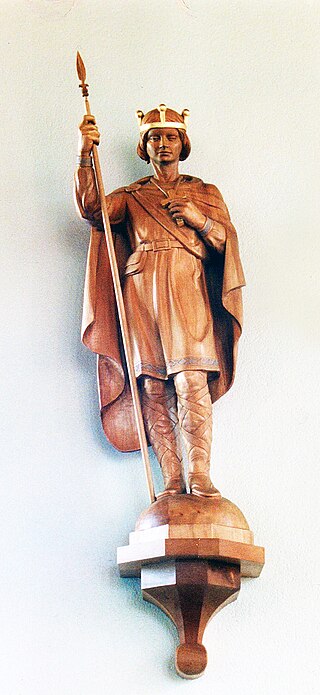
Saint Kenelm was an Anglo-Saxon saint, venerated throughout medieval England, and mentioned in the Canterbury Tales. William of Malmesbury, writing in the 12th century, recounted that "there was no place in England to which more pilgrims travelled than to Winchcombe on Kenelm's feast day".

A double monastery is a monastery combining separate communities of monks and of nuns, joined in one institution to share one church and other facilities. The practice is believed to have started in the East at the dawn of monasticism. It is considered more common in the monasticism of Eastern Christianity, where it is traceable to the 4th century. In the West the establishment of double monasteries became popular after Columbanus and sprang up in Gaul and in Anglo-Saxon England. Double monasteries were forbidden by the Second Council of Nicaea in 787, though it took many years for the decree to be enforced. Double monasteries were revived again after the 12th century in a significantly different way when a number of religious houses were established on this pattern among Benedictines and possibly the Dominicans. The 14th-century Bridgittines were purposely founded using this form of community.

Leoba, OSB was an Anglo-Saxon Benedictine nun and is recognized as a saint. In 746 she and others left Wimborne Minster in Dorset to join her kinsman Boniface in his mission to the German people. She was a learned woman and was involved in the foundation of nunneries in Kitzingen and Ochsenfurt. She had a leading role in evangelizing the area. Leoba was acclaimed for many miracles: saving a village from fire; saving a town from a terrible storm; protecting the reputation of the nuns in her convent; and saving the life of a fellow nun who was gravely ill – all accomplished through prayer.

Edith of Wilton was an English saint, nun and member of the community at Wilton Abbey, and the daughter of Edgar, King of England and Saint Wulfthryth. Edith's parents might have been married and Edgar might have abducted Wulfthryth from Wilton Abbey, but when Edith was an infant, Wulfthryth returned with Edith and their marriage was dissolved. Edith and her mother remained at Wilton for the rest of their lives.
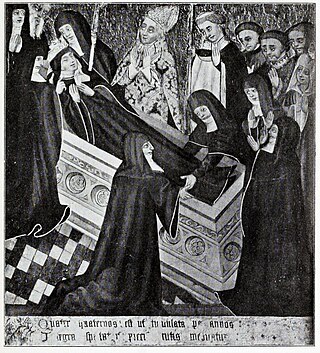
Seaxburh, also Saint Sexburga of Ely, was a Queen as well as an abbess, and is a saint of the Christian Church. She was married to King Eorcenberht of Kent.
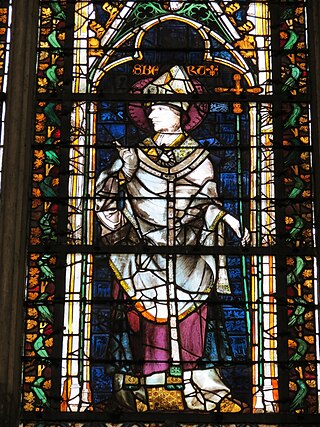
Ansbert, sometimes called Ansbert of Chaussy, was a Frankish monk, abbot and bishop of Rouen, today regarded as a saint in the Catholic Church.

Bega is a medieval Irish saint of Northumbria, venerated primarily in the town of St Bees. According to her Life, she was an Irish princess who fled to Northumbria to escape an arranged marriage to a Viking prince. She became an anchoress and was renowned for her piety. Multiple churches have been dedicated to her in England, and her feast day is still celebrated in St Bees.
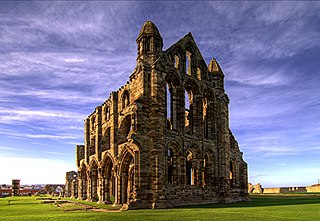
Saint Ælfflæd (654–714) was the daughter of King Oswiu of Northumbria and Eanflæd. She was abbess of Whitby Abbey, an abbey of nuns that were known for their skills in medicine, from the death of her kinswoman Hilda in 680, first jointly with her mother, then alone. Ælfflæd was particularly known for her skills in surgery and her personal attention to patients, as was Hilda, who was known for her personalized medical care.
Hackness is a village and civil parish in the Scarborough district of the county of North Yorkshire, England. It lies within the North York Moors National Park. The parish population rose from 125 in the 2001 UK census to 221 in the 2011 UK census.
Hartlepool Abbey, also known as Heretu Abbey, Hereteu Abbey, Heorthu Abbey or Herutey Abbey, was a Northumbrian monastery founded in 640 CE by Hieu, the first of the saintly recluses of Northumbria, and Aidan of Lindisfarne, on the Headland Estate of Hartlepool now called the Heugh or Old Hartlepool, in County Durham, England.
Kyneburga, Kyneswide and Tibba were female members of the Mercian royal family in 7th century England who were venerated as saints.
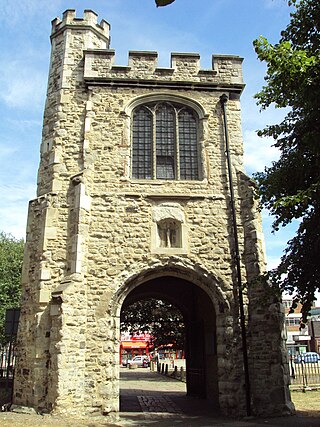
Hildelith of Barking, also known as Hildilid or Hildelitha, was an 8th-century Christian saint, from Anglo-Saxon England but was of foreign origin.